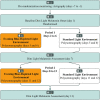Evening light environments can be designed to consolidate and increase the duration of REM-sleep
- PMID: 35610265
- PMCID: PMC9130237
- DOI: 10.1038/s41598-022-12408-w
Evening light environments can be designed to consolidate and increase the duration of REM-sleep
Abstract
Evening exposure to short-wavelength light has disruptive effects on circadian rhythms and sleep. These effects can be mitigated by blocking short-wavelength (blue) frequencies, which has led to the development of evening blue-depleted light environments (BDLEs). We have previously reported that residing 5 days in an evening BDLE, compared with residing in a normal indoor light environment of similar photopic lux, advances circadian rhythms and increases the duration of rapid eye movement (REM) sleep in a randomized cross-over trial with twelve healthy participants. The current study extends these findings by testing whether residing in the evening BDLE affects the consolidation and microstructure of REM sleep in the same sample. Evening BDLE significantly reduces the fragmentation of REM sleep (p = 0.0003), and REM sleep microarousals in (p = 0.0493) without significantly changing REM density or the latency to first REM sleep episode. Moreover, the increased accumulation of REM sleep is not at the expense of NREM stage 3 sleep. BDLE further has a unique effect on REM sleep fragmentation (p = 0.0479) over and above that of circadian rhythms phase-shift, indicating a non-circadian effect of BDLE. If these effects can be replicated in clinical populations, this may have a therapeutic potential in disorders characterized by fragmented REM sleep.
© 2022. The Author(s).
Conflict of interest statement
The authors declare no competing interests.
Figures



Similar articles
-
The evening light environment in hospitals can be designed to produce less disruptive effects on the circadian system and improve sleep.Sleep. 2021 Mar 12;44(3):zsaa194. doi: 10.1093/sleep/zsaa194. Sleep. 2021. PMID: 32954412 Free PMC article. Clinical Trial.
-
Effects on subjective and objective alertness and sleep in response to evening light exposure in older subjects.Behav Brain Res. 2011 Oct 31;224(2):272-8. doi: 10.1016/j.bbr.2011.05.029. Epub 2011 Jun 1. Behav Brain Res. 2011. PMID: 21664380 Free PMC article.
-
Systematic review of light exposure impact on human circadian rhythm.Chronobiol Int. 2019 Feb;36(2):151-170. doi: 10.1080/07420528.2018.1527773. Epub 2018 Oct 12. Chronobiol Int. 2019. PMID: 30311830
-
Wavelength-dependent effects of evening light exposure on sleep architecture and sleep EEG power density in men.Am J Physiol Regul Integr Comp Physiol. 2006 May;290(5):R1421-8. doi: 10.1152/ajpregu.00478.2005. Epub 2006 Jan 26. Am J Physiol Regul Integr Comp Physiol. 2006. PMID: 16439671 Clinical Trial.
-
Relationships between REM and NREM in the NREM-REM sleep cycle: a review on competing concepts.Sleep Med. 2020 Jun;70:6-16. doi: 10.1016/j.sleep.2020.02.004. Epub 2020 Feb 15. Sleep Med. 2020. PMID: 32179430 Review.
Cited by
-
Seasonal Variation in the Responsiveness of the Melanopsin System to Evening Light: Why We Should Report Season When Collecting Data in Human Sleep and Circadian Studies.Clocks Sleep. 2023 Nov 1;5(4):651-666. doi: 10.3390/clockssleep5040044. Clocks Sleep. 2023. PMID: 37987395 Free PMC article.
-
Habitual rapid eye movement sleep predicts changes in test-anxiety levels weeks in advance.J Sleep Res. 2025 Feb;34(1):e14298. doi: 10.1111/jsr.14298. Epub 2024 Jul 30. J Sleep Res. 2025. PMID: 39080966
-
Circadian therapy interventions for glymphatic dysfunction in concussions injuries: A narrative review.Sci Prog. 2023 Jul-Sep;106(3):368504231189536. doi: 10.1177/00368504231189536. Sci Prog. 2023. PMID: 37499049 Free PMC article. Review.
-
Can sleep patterns prior to negative emotional experiences predict intrusive memories?Sleep. 2024 Dec 11;47(12):zsae213. doi: 10.1093/sleep/zsae213. Sleep. 2024. PMID: 39271157 Free PMC article. No abstract available.
-
Effects of evening smartphone use on sleep and declarative memory consolidation in male adolescents and young adults.Brain Commun. 2024 May 17;6(3):fcae173. doi: 10.1093/braincomms/fcae173. eCollection 2024. Brain Commun. 2024. PMID: 38846535 Free PMC article.
References
Publication types
MeSH terms
LinkOut - more resources
Full Text Sources

